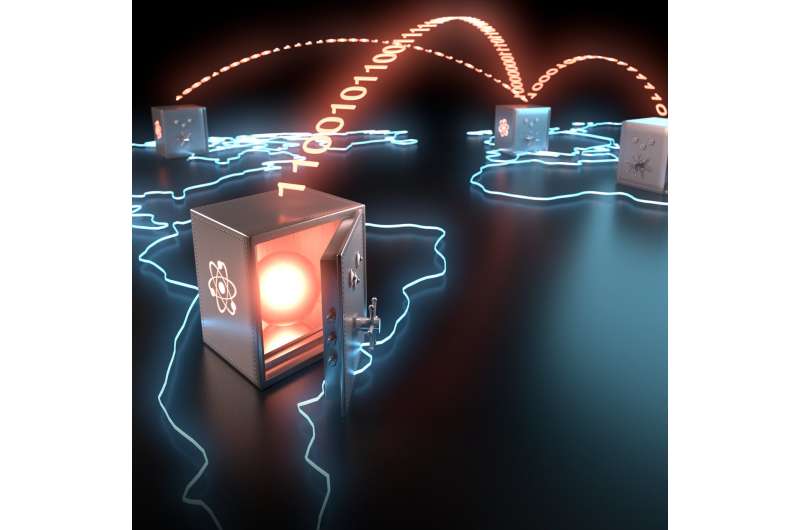Long-lived storage of a photonic qubit for worldwide teleportation

Concerning the development of quantum memories for the realization of global quantum networks, scientists of the Quantum Dynamics Division led by Professor Gerhard Rempe at the Max Planck Institute of Quantum Optics (MPQ) have now achieved a major breakthrough: they demonstrated the long-lived storage of a photonic qubit on a single atom trapped in an optical resonator. The coherence time of the stored quantum bit outlasts 100 milliseconds and therefore matches the requirement for the creation of a global quantum network in which qubits are directly teleported between end nodes. "The coherence times that we achieve represent an improvement by two orders of magnitude compared to the current state-of-the-art," says Professor Rempe. The study is published in Nature Photonics today.
Light is an ideal carrier for quantum information encoded on single photons, but transfer over long distances is inefficient and unreliable due to losses. Direct teleportation between the end nodes of a network can be utilized to prevent the loss of precious quantum bits. First, remote entanglement has to be created between the nodes; then, a suitable measurement on the sender side triggers the "spooky action at a distance," i.e. the instantaneous transport of the qubit to the receiver's node. However, the quantum bit may be rotated when it reaches the receiver and hence has to be reverted. To this end, the necessary information has to be classically communicated from sender to receiver. This takes a certain amount of time, during which the qubit has to be preserved at the receiver. Considering two network nodes at the most distant places on earth, this corresponds to a time span of 66 milliseconds.
In 2011, Professor Rempe's group has demonstrated a successful technique for storing a photonic quantum bit on a single atom. The atom is placed in the centre of an optical cavity which is formed by two high-finesse mirrors and hold in place by standing light waves. A single photon which carries the quantum bit in a coherent superposition of two polarization states starts to strongly interact with the single atom once it is sent into the resonator. Ultimately, the photon is absorbed by the atom and the quantum bit is transferred into a coherent superposition of two atomic states. The challenge is to maintain the atomic superposition as long as possible. In former experiments, the storage time was limited to a few hundreds of microseconds.
"The major problem for storing quantum bits is the phenomenon of dephasing," explains Stefan Langenfeld, a doctoral candidate at the experiment. "Characteristic of a quantum bit is the relative phase of the wave functions of the atomic states that are coherently superimposed. Unfortunately, in real-world experiments, this phase relation is lost over time mostly due to interaction with fluctuating ambient magnetic fields."
In their current experiment, the scientists take new measures to counteract the impact of those fluctuations. Once the information is transferred from the photon to the atom, the population of one atomic state is coherently transferred to another state. This is done by using a pair of laser beams to induce a Raman transition. In this new configuration, the stored qubit is 500 times less sensitive to magnetic field fluctuations.
Before the retrieval of the stored photonic quantum bit, the Raman transition is reversed. For a storage time of 10 milliseconds, the overlap of the stored photon with the retrieved photon is about 90%. This means, that the mere transfer of the atomic qubit to a less sensitive state configuration extends the coherence time by a factor of 10. Another factor of 10 was gained by adding a so-called "spin echo" to the experimental sequence. Here, the population of the two atomic states used for storage is swapped in the middle of the storage time. "The new technique allows us to preserve the quantum nature of the stored bit for more than 100 milliseconds," says Matthias Körber, a doctoral candidate at the experiment. "Although an envisioned global quantum network which allows for secure and reliable transport of quantum information still demands a lot of research, the long-lived storage of quantum bits is one of the key technologies and we believe that the current improvements will bring us a significant step closer to its realization."
More information: M. Körber et al. Decoherence-protected memory for a single-photon qubit, Nature Photonics (2017). DOI: 10.1038/s41566-017-0050-y
Journal information: Nature Photonics
Provided by Max Planck Society




















